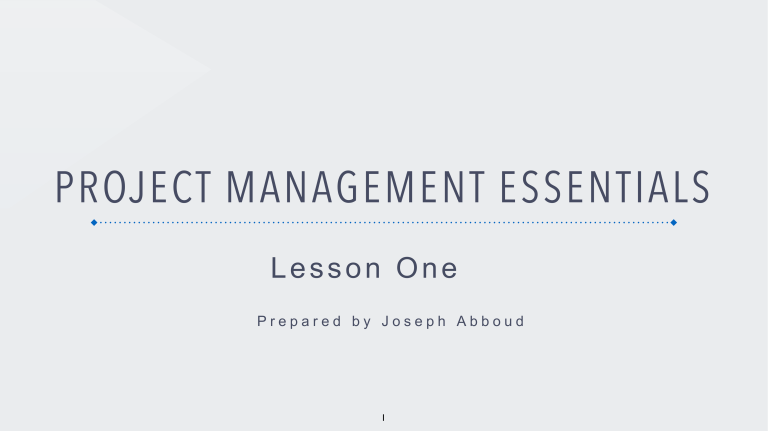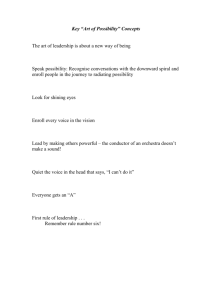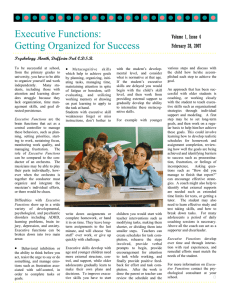
PROJECT MANAGEMENT ESSENTIALS Lesson One Prepared by Joseph Abboud 1 INTRODUCTION TO PROJECT MANAGEMENT Chapter 1 2 Learning Objectives • Clarify what project management is and “is not”. • Learn why projects are challenging to manage • Understand why project management is the key to the future growth of any organization. • The role of a project manager. • Influence of Project Manager Chapter 1 3 What Is Project Management...Exactly? “Project management is simply the process of managing projects. This definition does illustrate three key points: • Project management covers a vast array of subjects, processes, skills, and tools, but the key fundamentals of project management are straightforward and are consistent across industries. • To better understand project management, we need to understand what a project is. The nature of a project provides insights into the scope and challenges of project management. • To better understand project management, we need to understand what is implied by the term managing and how this compares against traditional business management.” Chapter 1 4 What Is a Project Exactly? A project is the work performed by an organization one time to produce a unique outcome. By one time, we mean the work has a definite beginning and a definite end, and by unique, we mean the work result is different in one or more ways from anything the organization has produced before. Examples of projects include the following: • Building a new house • Developing a new software application • Performing an assessment of current manufacturing processes • Creating a new radio commercial Chapter 1 5 What Is a Project Exactly? This is in contrast to the operations of an organization. The operational work is the ongoing, repetitive set of activities that sustain the organization. Examples of ongoing operations include the following: • Processing customer orders • Performing accounts receivable and accounts payable activities • Executing daily manufacturing orders To further explain the nature of projects (and project management) and how they compare to the ongoing operations of an organization, please review the summary in Table 1.1. Chapter 1 6 7 What Is a Project Exactly? Note: The Project Management Institute (PMI) definition of project is a temporary endeavor to produce a unique product or service. After reviewing this comparison, you are beginning to see the inherent challenges involved with project management. Projects are less predictable and are constantly impacted by the dynamic, uncertain nature of most organizational environments. Chapter 1 8 Managing Projects What do we mean when we say “managing projects”? • We mean applying both the science and art to planning, organizing, implementing, leading, and controlling the work of a project to meet the goals and objectives of the organization. • We mean the process of defining a project, developing a plan, executing the plan, monitoring progress against the plan, overcoming obstacles, managing risks, and taking corrective actions. • We mean the process of managing the competing demands and trade-offs between the desired • results of the project (scope, performance, quality) and the natural constraints of the project (time and cost).” We mean the process of leading a team that has never worked together before to accomplish something that has never been done before in a given amount of time with a limited amount of money. Chapter 1 9 Managing Projects Note: The PMI definition of project management is the application of knowledge, skills, tools, and techniques to project activities to meet project requirements. Chapter 1 10 Managing Projects To further assist this alignment process, let’s look at project management from a more academic level. PMI, the globally recognized standards organization for project management (www.pmi.org), defines project management as a set of five process groups (see Table 1.2)” Chapter 1 11 12 What Is the Value of Project Management? As the organizational operating environment continues to become more “global, more competitive, and more demanding, organizations must adapt. They must become more efficient, more productive—they must “do more with less.” They must continually innovate. They must respond rapidly to a fast-changing environment. How can they do this? How can they do this in a strategic manner? How can they do this and still have the proper management controls? They can do this with effective project management. The strategic value points that effective project management can offer an organization include, but are not limited by, the following: Chapter 1 13 What Is the Value of Project Management? • Provide a controlled way to rapidly respond to changing market conditions and new strategic opportunities • Maximize the innovative and creative capabilities of the organization by creating environments of focus and open communication • Enable organizations to accomplish more with less costs • Enable better leverage of both internal and external expertise • Provide key information and visibility on project metrics to enable better decision-making management. Chapter 1 14 What Is the Value of Project Management? • Increase the pace and level of stakeholder acceptance for any strategic change • Reduce financial losses by “killing off” poor project investments early in their life cycles Note: Stakeholder is the term used to describe individuals and organizations who are actively involved in the project or whose interests might be impacted by the execution or completion of the project. Chapter 1 15 What Is the Value of Project Management? In addition to providing apparent value to any organization, project management also offers tremendous value to each of us as individuals. At a personal level, the value of effective project management: • Ensures that our work is put to the best use for the organization and properly recognized • Provides a career path that offers unique, challenging opportunities on each new project • Provides a career path that requires all our abilities and knowledge, including our management, business, people, and technical skills • Provides a career path that is high in demand, and, generally, offers an increase in income • Provides a career path that prepares you for organizational leadership positions • Provides a career path that is recognized more each year as excellent preparation for CxO positions (as more CxO positions are filled by individuals with project management experience) • Provides a career path that enables you to be on the front lines of strategic organizational initiatives and have major impact on the organization’s future. Chapter 1 16 THE ROLE OF THE PROJECT MANAGER OVERVIEW The project manager plays a critical role in the leadership of a project team in order to achieve the project’s objectives. This role is clearly visible throughout the project. Many project managers become involved in a project from its initiation through closing. However, in some organizations, a project manager may be involved in evaluation and analysis activities prior to project initiation. These activities may include consulting with executive and business unit leaders on ideas for advancing strategic objectives, improving organizational performance, or meeting customer needs. 17 THE ROLE OF THE PROJECT MANAGER Membership and roles. A large project and an orchestra each comprise many members, each playing a different role. A large orchestra may have more than 100 musicians who are led by a conductor. These musicians may play 25 different kinds of instruments. Similarly, a large project may have more than 100 project members led by a project manager. Team members may fulfill many different roles, such as design, manufacturing, and facilities management. Like the major sections of the orchestra, they represent multiple business units or groups within an organization. The musicians and the project members make up each leader’s team. 18 THE ROLE OF THE PROJECT MANAGER Responsibility for team. The project manager and conductor are both responsible for what their teams produce—the project outcome or the orchestra concert, respectively. The two leaders need to take a holistic view of their team’s products in order to plan, coordinate, and complete them. The two leaders begin by reviewing the vision, mission, and objectives of their respective organizations to ensure alignment with their products. The two leaders establish their interpretation of the vision, mission, and objectives involved in successfully completing their products. The leaders use their interpretation to communicate and motivate their teams toward the successful completion of their objectives. 19 THE ROLE OF THE PROJECT MANAGER Knowledge and skills: The conductor is not expected to be able to play every instrument in the orchestra, but should possess musical knowledge, understanding, and experience. The conductor provides the orchestra with leadership, planning, and coordination through communications. The conductor provides written communication in the form of musical scores and practice schedules. The conductor also communicates in real time with the team by using a baton and other body movements. The project manager is not expected to perform every role on the project, but should possess project management knowledge, technical knowledge, understanding, and experience. The project manager provides the project team with leadership, planning, and coordination through communications. 20 THE ROLE OF THE PROJECT MANAGER The role of a project manager is distinct from that of a functional manager or operations manager. Typically, the functional manager focuses on providing management oversight for a functional or business unit. Operations managers are responsible for ensuring that business operations are efficient. The project manager is the person assigned by the performing organization to lead the team that is responsible for achieving the project objectives. 21 THE PROJECT MANAGER’S SPHERE OF INFLUENCE OVERVIEW Project managers fulfill numerous roles within their sphere of influence. These roles reflect the project manager’s capabilities and are representative of the value and contributions of the project management profession. The project manager in the various spheres of influence shown in Figure 3-1 (next slide). 22 THE PROJECT MANAGER’S SPHERE OF INFLUENCE 23 INFLUENCE OF THE PROJECT The project manager leads the project team to meet the project’s objectives and stakeholders’ expectations. The project manager works to balance the competing constraints on the project with the resources available. The project manager also performs communication roles between the project sponsor, team members, and other stakeholders. This includes providing direction and presenting the vision of success for the project. The project manager uses soft skills (e.g., interpersonal skills and the ability to manage people) to balance the conflicting and competing goals of the project stakeholders in order to achieve consensus. 24 INFLUENCE THE ORGANIZATION The project manager proactively interacts with managers within the organization during the course of the project. The project manager also works with the project sponsor to address internal political and strategic issues that may impact the team or the viability or quality of the project. The project manager also works to: Demonstrate the value of project management, Increase acceptance of project management in the organization, Advance the efficacy of the PMO when one exists in the organization. Depending on the organizational structure, a project manager may report to a functional manager. In other cases, a project manager may be one of several project managers who report to a PMO or a portfolio or program manager who is ultimately responsible for one or more organization-wide projects. 25 END OF CHAPTER ONE



